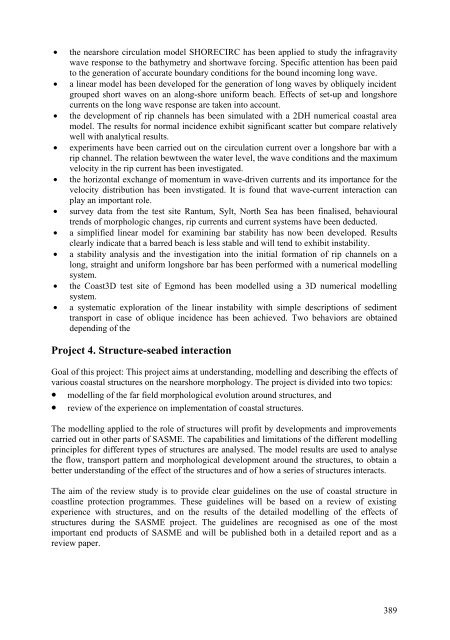EurOCEAN 2000 - Vlaams Instituut voor de Zee
EurOCEAN 2000 - Vlaams Instituut voor de Zee
EurOCEAN 2000 - Vlaams Instituut voor de Zee
You also want an ePaper? Increase the reach of your titles
YUMPU automatically turns print PDFs into web optimized ePapers that Google loves.
• the nearshore circulation mo<strong>de</strong>l SHORECIRC has been applied to study the infragravity<br />
wave response to the bathymetry and shortwave forcing. Specific attention has been paid<br />
to the generation of accurate boundary conditions for the bound incoming long wave.<br />
• a linear mo<strong>de</strong>l has been <strong>de</strong>veloped for the generation of long waves by obliquely inci<strong>de</strong>nt<br />
grouped short waves on an along-shore uniform beach. Effects of set-up and longshore<br />
currents on the long wave response are taken into account.<br />
• the <strong>de</strong>velopment of rip channels has been simulated with a 2DH numerical coastal area<br />
mo<strong>de</strong>l. The results for normal inci<strong>de</strong>nce exhibit significant scatter but compare relatively<br />
well with analytical results.<br />
• experiments have been carried out on the circulation current over a longshore bar with a<br />
rip channel. The relation bewtween the water level, the wave conditions and the maximum<br />
velocity in the rip current has been investigated.<br />
• the horizontal exchange of momentum in wave-driven currents and its importance for the<br />
velocity distribution has been invstigated. It is found that wave-current interaction can<br />
play an important role.<br />
• survey data from the test site Rantum, Sylt, North Sea has been finalised, behavioural<br />
trends of morphologic changes, rip currents and current systems have been <strong>de</strong>ducted.<br />
• a simplified linear mo<strong>de</strong>l for examining bar stability has now been <strong>de</strong>veloped. Results<br />
clearly indicate that a barred beach is less stable and will tend to exhibit instability.<br />
• a stability analysis and the investigation into the initial formation of rip channels on a<br />
long, straight and uniform longshore bar has been performed with a numerical mo<strong>de</strong>lling<br />
system.<br />
• the Coast3D test site of Egmond has been mo<strong>de</strong>lled using a 3D numerical mo<strong>de</strong>lling<br />
system.<br />
• a systematic exploration of the linear instability with simple <strong>de</strong>scriptions of sediment<br />
transport in case of oblique inci<strong>de</strong>nce has been achieved. Two behaviors are obtained<br />
<strong>de</strong>pending of the<br />
Project 4. Structure-seabed interaction<br />
Goal of this project: This project aims at un<strong>de</strong>rstanding, mo<strong>de</strong>lling and <strong>de</strong>scribing the effects of<br />
various coastal structures on the nearshore morphology. The project is divi<strong>de</strong>d into two topics:<br />
• mo<strong>de</strong>lling of the far field morphological evolution around structures, and<br />
• review of the experience on implementation of coastal structures.<br />
The mo<strong>de</strong>lling applied to the role of structures will profit by <strong>de</strong>velopments and improvements<br />
carried out in other parts of SASME. The capabilities and limitations of the different mo<strong>de</strong>lling<br />
principles for different types of structures are analysed. The mo<strong>de</strong>l results are used to analyse<br />
the flow, transport pattern and morphological <strong>de</strong>velopment around the structures, to obtain a<br />
better un<strong>de</strong>rstanding of the effect of the structures and of how a series of structures interacts.<br />
The aim of the review study is to provi<strong>de</strong> clear gui<strong>de</strong>lines on the use of coastal structure in<br />
coastline protection programmes. These gui<strong>de</strong>lines will be based on a review of existing<br />
experience with structures, and on the results of the <strong>de</strong>tailed mo<strong>de</strong>lling of the effects of<br />
structures during the SASME project. The gui<strong>de</strong>lines are recognised as one of the most<br />
important end products of SASME and will be published both in a <strong>de</strong>tailed report and as a<br />
review paper.<br />
389

















